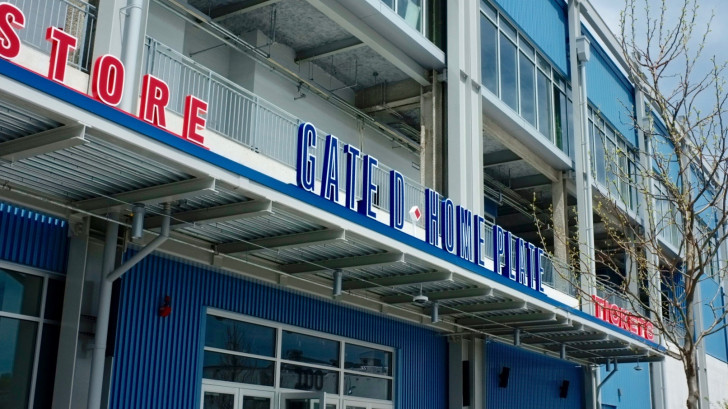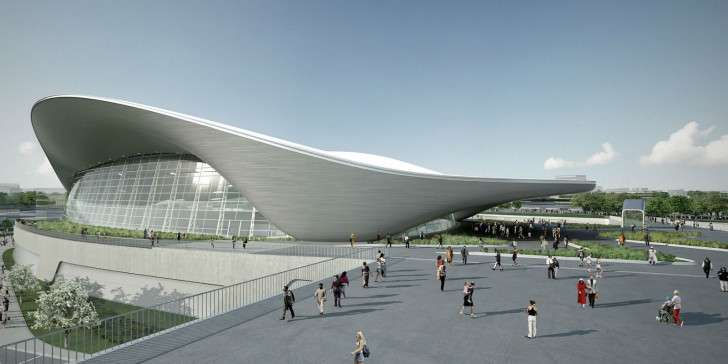Worcester’s Polar Park Is Underwhelming at $160 Million –– Architecture Critic Morgan
Monday, May 10, 2021
Baseball is returning to the Blackstone River Valley. On Tuesday, the Worcester Woo Sox host the Syracuse Mets for the season opener at Polar Park, the spanking new home of the Boston Red Sox farm team. The stadium that cost more than $160 million also highlights the failure of a silver-bullet sports arena to reverse inner-city decline.
GET THE LATEST BREAKING NEWS HERE -- SIGN UP FOR GOLOCAL FREE DAILY EBLAST
For half a century, the Red Sox Triple-A team played at McCoy Stadium in Pawtucket. While decidedly unglamorous, Paw Sox baseball was affordable; the entire family could enjoy an evening at McCoy for a fraction of Fenway Park admission. In short, Pawtucket represented the essence of minor league ball.
But removed to Worcester, baseball is no longer a mom-and-pop affair. Upgrading McCoy with the kind of amenities for high rollers, such as air conditioning, bars, and private boxes, was deemed too expensive. The sticking point was a demand for luxury.
Clubhouse plastic and concrete: the epitome of luxury? Photo: Will Morgan
How ironic, as Polar Park cannot be described as luxurious. Its public face is that of an Amazon warehouse or a giant shipping container. The renderings that helped sell the project showed the kind of brick facade that has wrapped almost every ballpark since Camden Yards in Baltimore was built in 1992. Although the dropping of the cutesy masonry facade was a plus, the exposed structure could have been strongly emphasized for a statement of Yankee industrial power. Given its enormous budget why does it look budget constrained?
This is surprising, as the designers of the 9,508-seat ball field, D'Agostino Izzo Quirk Architects are among the best in their field. DAIQ has done renovation work for the Phillies at Citizens Bank Park and at Dodger Stadium, as well as a recent makeover of Fenway. Polar Park is beautifully sited in term of views of
Worcester. You can see the field from all the seats, and the touted mirror image of Fenway is almost believable.
So why is Polar Park so underwhelming, especially as the developers promised an "innovative ballpark." The original estimate of $101 million for construction has ballooned to almost twice that figure three years later. This is probably the most expensive minor league ballpark ever built. As a major backer noted, the stadium "will look, feel, taste, and be–Worcester." And when the novelty wears off in a few years (as studies of Triple-A parks suggest it will), the aftertaste will be one of debt. What did the Commonwealth of Massachusetts get for their contribution, and when will Worcester's outlay of bonded dollars see a return?
Four giant fiberglass rings on the entrance plaza are the stadium's only decorative flourishes. PHOTO: Will Morgan
The Utica Unicorns recently completed a stadium outside of Detroit with some of the same amenities as the Woo Sox's new home. Jimmy John's Field seats only 4,500 fans, but it cost $ 15 million. At the other end of the scale, the aquatic center for the 2012 London Olympics came in at an astounding £ 269 million. Yet the design by Zaha Hadid is an absolute stunner, an enduring landmark that was conceived as a permanent natatorium for an economically disadvantaged part of London.
However disappointing the design of the Polar Park is, the issue is not so much an architectural shortcoming as a failure of city planning and a lack of vision. Worcester heard the siren song of flimflam like that of the Music Man, with the seductive appeal of a magic solution to urban ills. Putting all your faith and dollars in a stadium was an exhausted planning trope decades ago. Will Polar Park really hold 125 events a year? Will it ever pay its own way? Will it attract middle class families to move to Worcester? Is this the best way to spruce up a city with an image problem?
Cities such as Cincinnati, St Louis, and New Orleans gave up prime bits of downtown real estate for sports venues. Were the trade-offs worth it? I remember how Reds Stadium in Cincinnati brought in huge crowds. People came from out of town, parked in a wasteland where the historic waterfront had been, watched a game and maybe stayed in town for a meal, and then went back to their suburban or country homes. They contributed little to the life of downtown, except trash and pollution.
Polar Park is supposed to be the centerpiece of a major renovation of the Canal District, a somewhat down-at-the-heels neighborhood literally on the other side of the railroad tracks. The original scheme included a 225-unit apartment building, two hotels, and 65,000 square feet of retail and restaurants. A second phase was to add another 200,000 square feet of retail. Some of this construction–no doubt delayed by Covid–will occur on the large open lots across from the stadium entrance.
Madison Street, the heavily trafficked main drag in front of Polar Park, feels uncomfortably wide. This emphasizes the stadium's presence, but it hardly encourages a feeling of pedestrian safety. Yet, right around the corner is Green Street, a somewhat gritty, crowded, but lively area of juice, coffee, and booze bars, a public market, ethnic shops and bodegas, and Thai, Mexican, and Vietnamese restaurants. Is this the kind of real city that will be replaced by the new development?
The stark contrast between a viable urban experience and a behemoth stadium that comes alive only when its fans are here demonstrates a tragic misunderstanding of what makes a city livable and appealing. Polar Park may be good for minor league ball, but it is s stick in the eye for the city of Worcester.
GoLocal architecture critic William Morgan has been written about design and cities for a variety of newspapers including the New York Times, the Cleveland Plain Dealer, and the Christian Science Monitor. He has been a Red Sox fan since the Braves abandoned Boston.
Editorial Note: An earlier version of this story stated that Camden Yards opened in 1982, it was actually 1992.
Related Articles
- Urban Wish List – Architecture Critic Morgan
- The Post-COVID Office –– Architecture Critic Morgan
- In Praise of the Post Office –– Architecture Critic Morgan
- The Best and Worst of New Construction on the East Side–– Architecture Critic Morgan
- A New Gateway for Pawtuxet Village – Architecture Critic Morgan
- Brown’s New Policy Toward Old Houses –– Architecture Critic Morgan
- RI’s Celebrated Architect St. Florian Breaking the Code in Fox Point – Architecture Critic Morgan
- Embracing Sidewalk Culture – Architecture Critic Morgan
- Post Pandemic Providence – Architecture Critic Will Morgan
- RIPTA’s New Bust Shelters––Architecture Critic Morgan
- The Invasion of the Over-Scaled Buildings––Architecture Critic Will Morgan
- Two East Side Apartment Blocks –– Architecture Critic Morgan
- Providence’s New Apartments: Wrong Building, Wrong Place –– Architecture Critic Will Morgan
- “What Can Brown Do for You?” University’s New Mega Project –– Architecture Critic Morgan
- East Providence Is the Future –– Architecture Critic Will Morgan
- Saving Newport by Destroying It? –– Architecture Critic Morgan
- New Hope for Old Bones: Grace Cemetery––Architecture Critic Morgan
- The New Rhode Island License Plate: A Plea for a Dignified Design – Architecture Critic Morgan
- Are We Designing Better Looking Parking Garages Than Hotels—Architecture Critic Morgan
- Newport’s Most Fascinating Neighborhood – Architecture Critic Will Morgan
- A Modest Proposal for Smith Street –– Architecture Critic Morgan
- Brown Versus the Neighbors, Again – Architecture Critic Morgan
- Newport’s $100 Million Fixer Upper - Architecture Critic Will Morgan
- Modern Master: Ira Rakatansky –– Architecture Critic Morgan
- Worcester’s Polar Park Is Underwhelming at $160 Million –– Architecture Critic Morgan
- Leading Stadium Expert Criticizes Worcester for Polar Park Cost Overruns
- Whitcomb: Perilous Pause; The Polar Park Era; The Quiet Mega-Crook
- Worcester Hires Architectural Firm to Design New PawSox Stadium
- Worcester Launches Video Illustration of New PawSox Stadium
- Will Rhode Islanders Attend the PawSox’ Final Years?
- Gilbane Building Company & Hunt Named Construction Managers for New PawSox Stadium
- EDITORIAL: Hey, PawSox, Don’t Let the Turnstile Hit You On Your Way to Worcester
- Pawtucket Spent $273K in Legal, Consulting Fees for Construction of Failed PawSox Stadium
- PawSox Seek to Establish New Team Name for Worcester Move
- Worcester Labor, Community Groups Seeking “Signed Benefit Agreement” on PawSox Projects
- Commerce’s Pryor Says RI’s Economy is Hitting Record Levels - Talks PawSox, GE, Superman, and More
- GAME OVER: PawSox Attendance Fell By Nearly 40 Percent in the Past 13 Years
- 1-on-1 with Mattiello: Re-Election, Abortion Rights, Line-Item Veto, Raimondo and PawSox
- PawSox Schedule “Ladies Day” Promotion in August, Featuring Stemless Wine Glasses
- City of Worcester to Expand Development Around PawSox Stadium
- NEW: PawSox Unveil New Logo and Name for Worcester
- PawSox Receive Small Business Funds Under PPP Via Federal Stimulus
- Death of the PawSox: A Betrayal of Trust
- New England Pride TV Starring Dale LePage - Featuring PawSox President Steinberg
- PawSox Issue Apology About Including Sean Spicer and Chick-fil-A on Pride Night
- Worcester Acquires Additional Properties Around New PawSox Stadium
- PawSox Face a Big Little Challenge in Worcester
- PawSox to Induct Clemens Into Hall of Fame Despite Short Stint, Steroid Allegations
- City of Worcester Breaks Ground on New PawSox Stadium
- Black Lives Matter Movement Sets Sights on PawSox Ownership With Protest on Thursday











